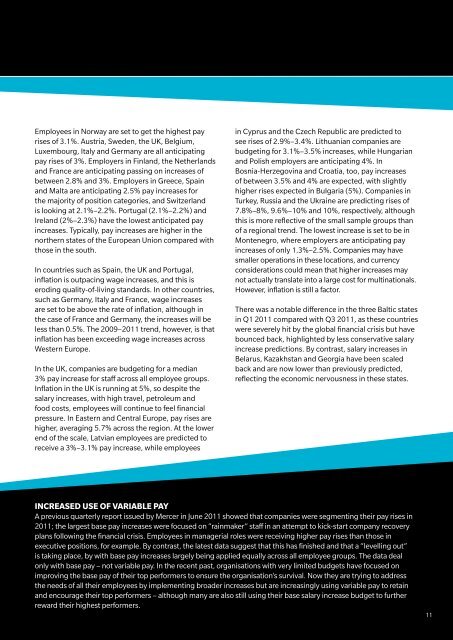A SERIES OF ARTICLES FRoM THE 2011 EMEA CoMPENSATIoN ...
A SERIES OF ARTICLES FRoM THE 2011 EMEA CoMPENSATIoN ...
A SERIES OF ARTICLES FRoM THE 2011 EMEA CoMPENSATIoN ...
Create successful ePaper yourself
Turn your PDF publications into a flip-book with our unique Google optimized e-Paper software.
Employees in Norway are set to get the highest pay<br />
rises of 3.1%. Austria, Sweden, the UK, Belgium,<br />
Luxembourg, Italy and Germany are all anticipating<br />
pay rises of 3%. Employers in Finland, the Netherlands<br />
and France are anticipating passing on increases of<br />
between 2.8% and 3%. Employers in Greece, Spain<br />
and Malta are anticipating 2.5% pay increases for<br />
the majority of position categories, and Switzerland<br />
is looking at 2.1%–2.2%. Portugal (2.1%–2.2%) and<br />
Ireland (2%–2.3%) have the lowest anticipated pay<br />
increases. Typically, pay increases are higher in the<br />
northern states of the European Union compared with<br />
those in the south.<br />
In countries such as Spain, the UK and Portugal,<br />
inflation is outpacing wage increases, and this is<br />
eroding quality-of-living standards. In other countries,<br />
such as Germany, Italy and France, wage increases<br />
are set to be above the rate of inflation, although in<br />
the case of France and Germany, the increases will be<br />
less than 0.5%. The 2009–<strong>2011</strong> trend, however, is that<br />
inflation has been exceeding wage increases across<br />
Western Europe.<br />
In the UK, companies are budgeting for a median<br />
3% pay increase for staff across all employee groups.<br />
Inflation in the UK is running at 5%, so despite the<br />
salary increases, with high travel, petroleum and<br />
food costs, employees will continue to feel financial<br />
pressure. In Eastern and Central Europe, pay rises are<br />
higher, averaging 5.7% across the region. At the lower<br />
end of the scale, Latvian employees are predicted to<br />
receive a 3%–3.1% pay increase, while employees<br />
in Cyprus and the Czech Republic are predicted to<br />
see rises of 2.9%–3.4%. Lithuanian companies are<br />
budgeting for 3.1%–3.5% increases, while Hungarian<br />
and Polish employers are anticipating 4%. In<br />
Bosnia-Herzegovina and Croatia, too, pay increases<br />
of between 3.5% and 4% are expected, with slightly<br />
higher rises expected in Bulgaria (5%). Companies in<br />
Turkey, Russia and the Ukraine are predicting rises of<br />
7.8%–8%, 9.6%–10% and 10%, respectively, although<br />
this is more reflective of the small sample groups than<br />
of a regional trend. The lowest increase is set to be in<br />
Montenegro, where employers are anticipating pay<br />
increases of only 1.3%–2.5%. Companies may have<br />
smaller operations in these locations, and currency<br />
considerations could mean that higher increases may<br />
not actually translate into a large cost for multinationals.<br />
However, inflation is still a factor.<br />
There was a notable difference in the three Baltic states<br />
in Q1 <strong>2011</strong> compared with Q3 <strong>2011</strong>, as these countries<br />
were severely hit by the global financial crisis but have<br />
bounced back, highlighted by less conservative salary<br />
increase predictions. By contrast, salary increases in<br />
Belarus, Kazakhstan and Georgia have been scaled<br />
back and are now lower than previously predicted,<br />
reflecting the economic nervousness in these states.<br />
INCREASED USE <strong>OF</strong> VARIABLE PAY<br />
A previous quarterly report issued by Mercer in June <strong>2011</strong> showed that companies were segmenting their pay rises in<br />
<strong>2011</strong>; the largest base pay increases were focused on “rainmaker” staff in an attempt to kick-start company recovery<br />
plans following the financial crisis. Employees in managerial roles were receiving higher pay rises than those in<br />
executive positions, for example. By contrast, the latest data suggest that this has finished and that a “levelling out”<br />
is taking place, by with base pay increases largely being applied equally across all employee groups. The data deal<br />
only with base pay – not variable pay. In the recent past, organisations with very limited budgets have focused on<br />
improving the base pay of their top performers to ensure the organisation’s survival. Now they are trying to address<br />
the needs of all their employees by implementing broader increases but are increasingly using variable pay to retain<br />
and encourage their top performers – although many are also still using their base salary increase budget to further<br />
reward their highest performers.<br />
13 11
















